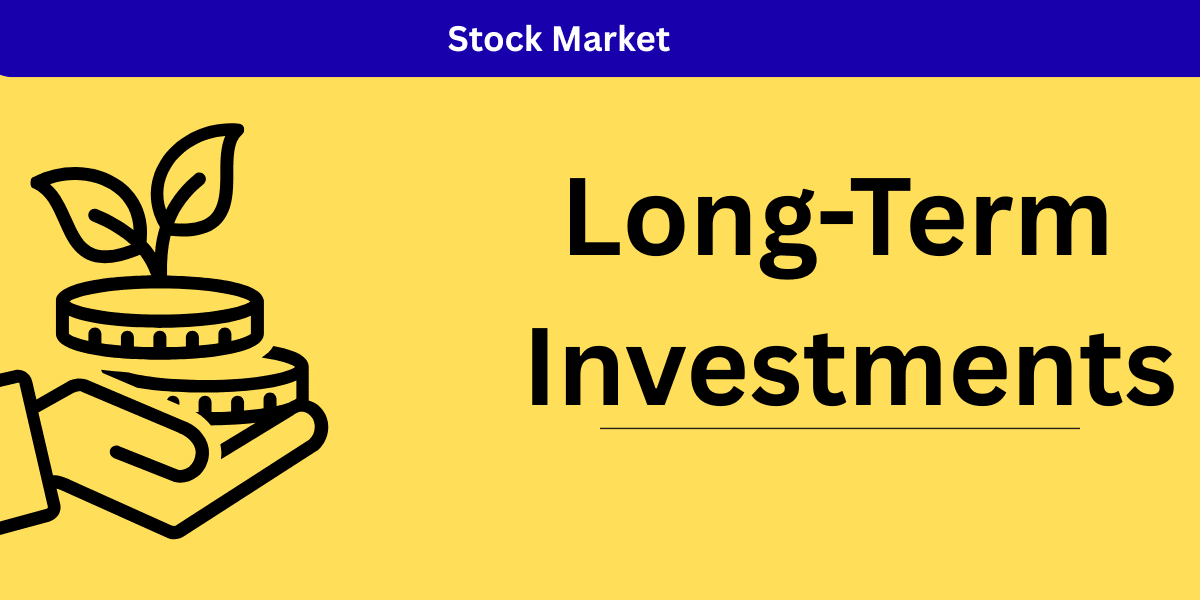When it comes to building wealth over time, long term investments are among the most effective and reliable strategies. These investments not only help you beat inflation but also create a foundation for your financial future. If you’ve ever wondered how long-term investments are carried at, or you’re searching for good long term investment options, this guide will provide you with in-depth answers.
Let’s dive into the concept, explore popular long term investment plans, and understand their advantages in a way that’s easy, practical, and based on real-world insights.

Table of Contents
What is long-term investment?
A long-term investment is an asset or financial product that you hold for an extended period—typically five years or more. The purpose of a long-term investment is not to get rich overnight but to accumulate wealth gradually by harnessing the power of compounding and market growth.
These investments include:
- Stocks and mutual funds
- Real estate
- Bonds and government securities
- Retirement accounts like PPF, EPF, NPS
- Index funds and ETFs
Key Characteristics:
- Duration: Usually held for 5 to 30 years
- Objective: Wealth creation, retirement planning, long-term goals like children’s education or home buying
- Risk Level: Depends on the investment type but often lower over time
How Long Term Investments Are Carried At Simplified
The term “carried at” generally refers to how investments are recorded and maintained over time.
In Accounting Terms:
For businesses, long term investments are usually carried at historical cost or fair market value, depending on the accounting standard followed. If the value of a long term investment falls below its cost permanently, the value is adjusted.
For Individual Investors:
You can think of “carrying” a long term investment as:
- Buying an asset (like a mutual fund or stock)
- Holding it over the years
- Monitoring its performance, but not reacting to short-term market volatility
This is where time turns into your greatest strength. With patience, even volatile investments tend to grow in value.
Types of Long Term Investment Plans
Let’s take a closer look at the most popular long-term investment options in India and around the world.
1. Public Provident Fund (PPF)
- Backed by the government
- 15-year lock-in
- Tax-free returns under Section 80C
- Great for conservative investors
2. National Pension Scheme (NPS)
- Designed for retirement
- Invests in equity, corporate bonds, and government securities
- Low cost, tax-saving, long maturity
3. Equity Mutual Funds
- Managed by professional fund managers
- Long-term potential for high returns
- Diversification reduces risk
- SIP option makes it affordable
4. Direct Stocks
- High risk, high reward
- Ideal for knowledgeable investors
- Long-term holdings of blue-chip companies can yield exponential growth
5. Real Estate
- Tangible asset
- Appreciation over decades
- Can generate rental income
- Requires large capital and long holding period
6. ULIPs (Unit Linked Insurance Plans)
- Insurance + investment product
- Lock-in of 5 years minimum
- Suitable for long-term planning
7. Sukanya Samriddhi Yojana (for girl child)
- High interest
- 21-year maturity
- Tax benefits
How to Choose Good Long Term Investment Options

Here’s what to consider before investing:
1. Risk Appetite
Evaluate how much risk you can take. For example:
- Low risk: Bonds, PPF
- Medium risk: Balanced mutual funds, NPS
- High risk: Equity mutual funds, direct stocks
2. Financial Goals
Define your goal — buying a house, retirement, education, etc. This helps you select a plan with the right time horizon and returns.
3. Time Frame
The more time you give your investments, the harder compounding works for you.
4. Liquidity Needs
Some plans like PPF or ULIPs have lock-in periods. Make sure your money won’t be needed urgently.
5. Tax Implications
Look for tax-saving options like ELSS, PPF, or NPS that not only give returns but reduce your taxable income.
10 Best Long Term Investment Strategies for 2025 and Beyond
Here are actionable strategies you can follow:
- Start investing early to maximize compounding.
- Automate your investments using SIPs.
- Diversify across asset classes.
- Rebalance your portfolio every year.
- Keep an emergency fund aside.
- Don’t react to short-term market noise.
- Review your goals annually.
- Use tax-advantaged accounts.
- Focus on quality assets.
- Stay invested for at least 5-10 years.
Advantages of Long Term Investment
Why is long-term investing so powerful? Let’s explore its top benefits:
1. Compounding Returns
With time, you don’t just earn returns on your money you also earn on the returns you’ve already made.
2. Lower Risk Over Time
Long-term investments ride out short-term market volatility.
3. Less Stress
You don’t have to time the market or track daily trends.
4. Cost Efficiency
Holding for longer reduces transaction costs, brokerage fees, and taxes.
5. Tax Benefits
Long-term capital gains tax is lower than short-term, and many plans offer Section 80C benefits.
6. Retirement Security
Investing over decades builds a stable nest egg for the future.
Common Myths About Long Term Investments
1: You need a lot of money to begin investing.
Reality: SIPs let you start with just ₹500 a month that’s less than your weekend dinner.
2: Stocks are too risky
Risk reduces significantly over a long horizon.
3: Real estate always appreciates
Location and timing matter. Real estate has risks too.
4: Gold is the safest long-term asset
Gold performs well during inflation but doesn’t always beat equity returns.
FAQs:
Q1. What is considered a long term investment?
ANSWER: An investment held for more than 5 years, with the intention of wealth creation over time.
Q2. Is it better to invest in mutual funds or stocks for the long term?
ANSWER: Mutual funds are ideal for beginners, while stocks suit experienced investors.
Q3. Which is the safest long term investment?
ANSWER: Government-backed instruments like PPF and NPS are among the safest.
Conclusion: Building Wealth, One Step at a Time
To sum it up long term investments are not about chasing quick wins but playing the slow and steady game. Understanding how long term investments are carried at, exploring the best long term investment plans, and recognizing their advantages puts you miles ahead on your financial journey.
Whether you’re just starting or refining your strategy, now is the best time to invest in your future.
Stay patient. Stay invested. Let your money grow.
